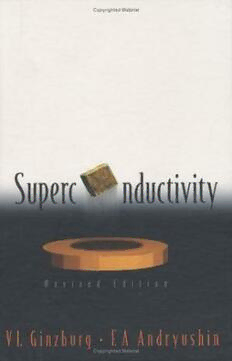Table Of ContentThis page intentionally left blank
Published by
World Scientific Publishing Co. Pte. Ltd.
5 Toh Tuck Link, Singapore 596224
USA office: 27 Warren Street, Suite 401402, Hackensack, NJ 07601
UK office; 57 Shelton Street, Covent Garden, London WC2H 9HE
British Library Cataloguing-in-PublicationD ata
A catalogue record for this book is available from the British Library.
SUPERCONDUCTIVITY
Revised Edition
Copyright 0 2004 by World Scientific Publishing Co. Pte. Ltd.
All rights reserved. This book, or parts thereoj may not be reproduced in any form or by any means,
electronic or mechanical, including photocopying, recording or any information storage and retrieval
system now known or to be invented, without written permission from the Publisher.
For photocopying of material in this volume, please pay a copying fee through the Copyright
Clearance Center, Inc., 222 Rosewood Drive, Danvers, MA 01923, USA. In this case permission to
photocopy is not required from the publisher.
ISBN 98 1-238-91 3-X
Printed by FuIsland Offset Printing (S) Pte Ltd, Singapore
To the Reader
Superconductivity is a physical phenomenon which is customarily
described without grudging epithets. Indeed, its nature had remained
unclear for many years. To discover the mechanism of this pheno-
menon, several decades of efforts of many physicists were needed.
But even now, after the discovery in 1986 and 1987 of the so-called
high-temperature superconductors, superconductivity is still under a
veil of mystery some key questions have yet to be answered. But
~
to approach them, we first have to trace the path traversed.
We shall tell you what superconductivity is, how it was discovered,
what its main properties are, where superconductors are applied now
and how they are most likely to be widely used in future.
We hope that our book will be the simplest of all popular books
devoted to superconductivity in the recent past. At the same time,
however, it will be less detailed and the least precise. The reader
should not be surprised if in more extensive books, he comes across
statements in more precise formulations than those given in our book.
We have not always indicated the necessity of such a specification lest
the text be overloaded with footnotes and digressions.
This book is organized by the canon of increasing complication,
from the first discovery over eighty years ago through many years
of studies to the latest sensations. The reader may choose topics
according to his interests. To have an idea of superconductivity, it
suffices to read the chapter on its discovery, and after that one can read
V
vi TO THE READER
chapters on its applications and those describing the superconducting
boom. The chapters “Physics of Superconductivity” and “The Nature
of Superconductivity” will be useful for those who take an interest in
physics, which is our greatest desire.
Preface to the Revised Edition
Several years after the discovery of High-T, superconductors (HTS)
in 1986-87, there was an expectation of a boom in superconductivity.
This small book was first written in 1989. It was the time when much
enthusiasm was seen in the discovery of HTS. Now, in 2004, it is clear
that the hopes raised for the widespread usage of HTS technology
may have been over-inflated.
But superconductivity applications are nevertheless enormous,
more so for the usual Low-T, superconductors than for the new
High-T, ones. Let us name the Low-T, superconductors as LTS, and
the High-T, superconductors as HTS; such abbreviations are generally
recognizable.
This book is aimed at readers with an interest in physics and
driven by a curiosity to learn more about nature. The understanding
of the mechanism and processes in HTS is the focus of attention.
To understand what occurs in HTS (as we did earlier for LTS) and
then to try and create a substance which is superconducting at room
temperature is one of the grand missions of solid state physicists. As
before, we can name Room-T, superconductors as RTS. But now RTS
seems to be only a dream. However, let us not forget that HTS was
also only a dream before 1986. Science needs new people to make
dreams come true so it makes great sense in having a new edition.
-
Although the changes in this new edition are minor, let us hope it will
be useful to the aspiring readers.
vii
This page intentionally left blank
Contents
To the Reader V
Preface to the Revised Edition vii
1 The Discovery of Superconductivity 1
The Beginning 1
Metals 3
Resistance 3
Residual Resistivity 5
Critical Temperature 5
Low Temperatures 7
The Meissner Effect 9
Magnetic Field 10
Currents and Fields in Superconductors 11
Ideal Diamagnetism 14
Some Facts from History 14
2 Physics of Superconductivity 19
How to verify that the Resistance of a Superconductor is
actually Zero? 19
Phase Transition 20
Specific Heat 23
Two Types of Electrons 25
ix

